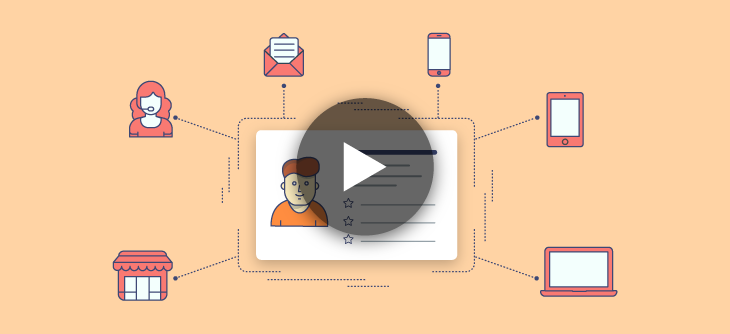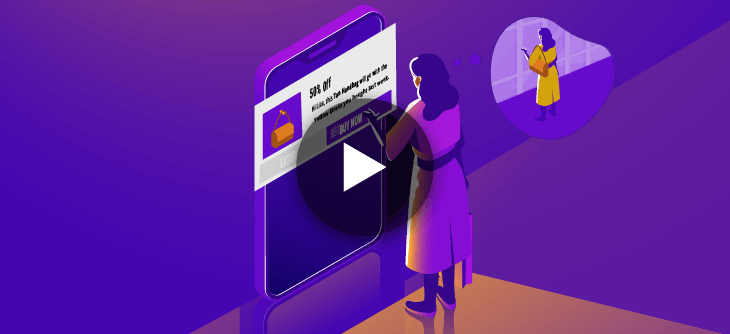Webinar Transcript
Avantika: Hello, and welcome to the webinar by WebEngage. This is Avantika Pandey, and today we are here to talk about the various challenges faced by marketers while creating an omnichannel marketing strategy. We have with us today, Mr. Vavek Singh, senior vice president of marketing and analytics at FirstCry, Asia’s largest online shopping store for kids and baby products. Welcome, Vivek. Tell us something about yourself.
Vivek: Thanks, Avantika. Hey, everyone, this is Vivek. I’ve been taking care of digital marketing and analytics at firstcry.com for the last five years. FirstCry is an omnichannel retail player in baby and kids space. We have a one-stop e-commerce store and approximately 180 offline stores. Both the online and offline strategies have been operating in tandem since last five years.
Through this years, I’ve seen how we started from been a single desktop fronted website, and how we moved into offline stores, mobile web, and mobile app. Previously, I’ve worked with HT Media, The Hindustan Times Group, for a brief period within their print division, and for a larger period within their internet division, which runs a few classifieds and content properties.
Avantika: Okay. Before we start the webinar, here are a few pointers for everyone. The presentation has already been shared with you in the handouts section. And if you have any query at any point of the webinar, please share with us in the question section in your Go-To-Webinar panel. We will address them at the end of the webinar. Now, I request Vivek to take it over from here. Over to you, sir.
Vivek: Thank you. So through these nine years of having worked in this space of internet content, classifieds, and e-commerce verticals, I have observed how marketing has evolved from a very simple spray and pray model to a far more complex conversion driven customer-centric omnichannel play. We’ll talk about why and how of this complexity, and how marketers are managing it best.
But before we start that, let’s look a very popular internet joke. There’s no gender bias intended in this joke, we’re just making a joke of a joke. A man and a woman go to a mall to buy a pair of pants. The man is able to complete the job in six minutes at the cost of two and a half pounds, whereas the woman takes very long winded route, spending three and a half hours and £50. Now, this joke is just a joke but with a few corrections, it represents a very strong marketing reality.
Correction number one. This is not about women versus men. Instead, it is about everyone, now versus then. The purchase behavior past versus present. Just a few years back, let’s say in the days of Nokia 1100, if I needed to buy a phone, I needed to walk into a mobile phone store, see and pay and bring it home. Recently, which was just last month when I needed to buy a phone, my purchase path would be the woman of this joke. I went to multiple offline stores, multiple online stores, checked the demo pieces, compared features, checked prices, checked for deals, checked for cash back on banks, checked for delivery timelines, even paid a faster delivery charge, and then eventually got it.
Believe me, this would be the nightmare of the marketing people streams. That is also about the correction number two of this joke. It is not just shops in the malls that are being browsed. Customers are searching on Google for information around products, people are listening to what others are saying around the products on social media, they’re checking for reviews of the product, of the seller, of the store. They’re building carts, sometimes abandoning it, sometimes returning to their carts with some coupon in their hand. They’re looking for seasonal sales, offers, deals website, this list is endless. It’s a very, very large variety of behavior that’s in play before a purchase happens.
And the third correction in this joke is that the marketer does not get 20 times more revenue just because the purchase path is 20 times longer. The marketer gets the same wallet share even if they do things right. And which is why it is necessary to recognize this complexity and do our best to be able to retain the modern customer. We now live in a world where customers are using an infinite combination of ways to discover, research, and decide before they buy, which is why businesses and marketers need to be seamlessly present for all customers across all myriad of these touchpoints at all times delivering consistent, convincing, experience and service. And this is what we’re terming as omnichannel marketing.
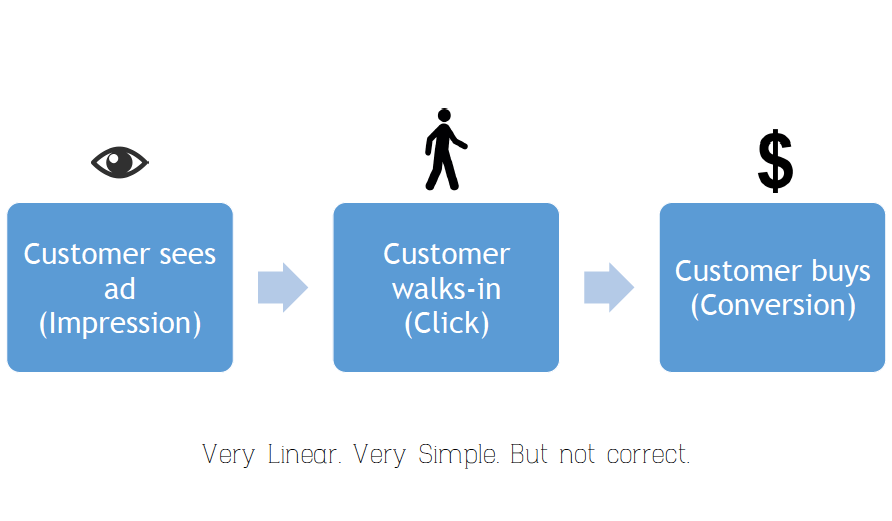
Let’s look at how marketers imagined the customer flow not too long ago. A customer would see an ad, then the customer would walk into the store, and then the customer would purchase. In the online world, this would be called an impression, a click, and a conversion. It’s very linear to visualize, very simplified, but not correct. Customers do not purchase in a linear fashion. They go through several impressions, several clicks within different marketing channels across different devices, online, offline before a purchase usually happens.
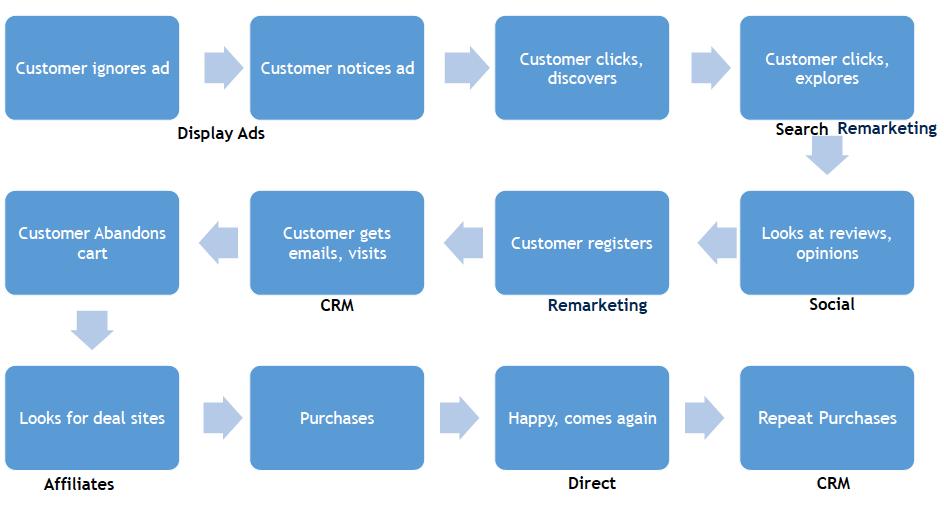
On slide number 11, we have tried to depict this complexity to some degree. It’s a flow of a potential customer from the moment of their first discovery to the moment where they become your loyal customers. Now, the potential customer is going to ignore your first few impressions. While we may want them to notice and act on everything we say, it will take a few impressions before the user even becomes aware of who we are. After a few more impressions, the customer might notice the ad, and then the customer might start interacting with the ad. They might click on the ad and end up at our store.
They’ll make an impression about that store, might not do anything more at that point of time. It will take few more attempts from our side where the customer might really start exploring the store, they might across certain things that they like to buy. Then they might invest some time in researching around those things, researching around the store. You can also expect to get a customer care inquiry around the product, features, or delivery timelines.
At some point of time, they’ll also register on your store if registration is part of a flow. After registering, they might start receiving newsletters and offers. One of those might start looking attractive to them, and they might come and build a cart. They might also abandon the cart midway looking for more reviews or going for more offers. Eventually, if everything goes right, we’ll have a purchase. In these part, they might also walk into an offline store of your brand or of a competition brand to understand, touch and feel the products that they’re getting.
After the purchase, if the experience is good, they’ll become a loyal customer and then start repeating with you again. Now, let’s look at were the different marketing channels that we’re all familiar with come in into picture. On an average, each of these channels will appear at different points in the flow. The display channels will fall right at the start of the flow where the customer is discovering you for the first time. These are the channels where you’re reaching out to a fresh set of audience telling them about your proposition. These are users who do not know you yet and hence will be less disposed to shop at your store immediately.
While you might record a few conversions, these channels serve the larger purpose of reaching out to a new audience and bringing them into this flow of purchase decision making. Once the customer start visiting this store, channels such as the marketing will…they can be, customer might also searching on Google because now they know that this is a category that can be bought online.
Your ad might come up in SEM and help them to explore a little further. Once they’ve registered on your CRM, the CRM engine kicks in and they start coming back to the store faster. At some point in time, some price-conscious customers will start using your affiliates, which indicates of e-commerce are mostly deals websites, price comparison websites, and cashback websites. Since the customer knows you are slightly better by now, they’ll start coming to your website directly as well.
In one of these later stages, they’ll make a purchase. If they’re happy with your experience, the CRM system should start becoming stronger and bringing them back to your site much more strongly, as they’ll be much more responsive to the messages they receive from you. This sources, which are at the start of this path are the discovery sources. They help with the awareness of your brand, they help the customer move further down the path.
This channels might not have the best conversion as the customer intention to purchase at that point of time is really low. The sources that are toward the later part of the flow are low in discovery but are very high on conversions as the customer’s intentions are stronger. We’ll have to recognize this difference between the channels at the start and the channels at the end, and our investment and expectations of ROI from each of these channels should be similarly graded.
Now, this is not the end of it, It becomes even more complex from here. Firstly, not all customers will be following this predefined route. We’ll see customers jumping from one stage to the other.
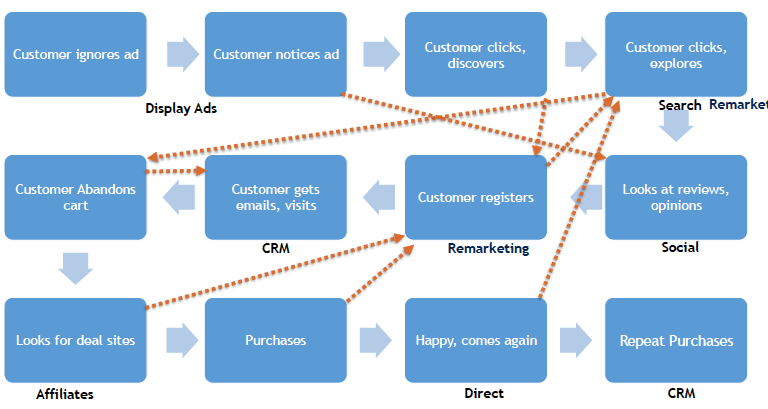
There’ll be some earlier adopters who will opt through the purchase flow much faster. There’ll be some deal seekers who’ll keep running back to coupon websites and deal websites. They’ll be some customers which will rightfully spend a lot of time making sure that the product that they’re buying is the best product out there.
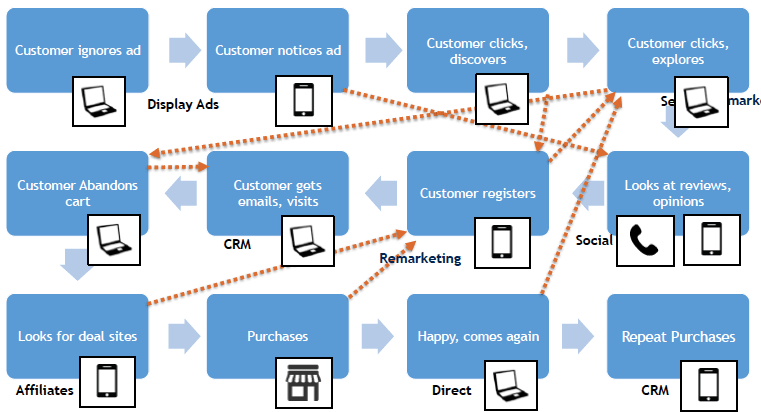
The second complication in this is that all of these is happening across multiple devices and formats, both in the offline and the online space. Someone might have built a cart on their office computer, but might be standing in a store right now, an offline store right now, while at the same time checking out prices on another online stores that they can use their cellphone to access.
In summary, what we’re saying is that we have moved far, far away from a linear flow of impression to click to conversion. It has become a lot more evolved, and we’ll have to address this evolution. This is an evolution over time from a simplistic single channel marketing where you’d run an ad, drive traffic, and drive sales, to a multi-channel marketing where you started doing the same across several new internet marketing channels. And then that moved to a cross-channel marketing where you need to recognize the impact that one channel was having on the other.
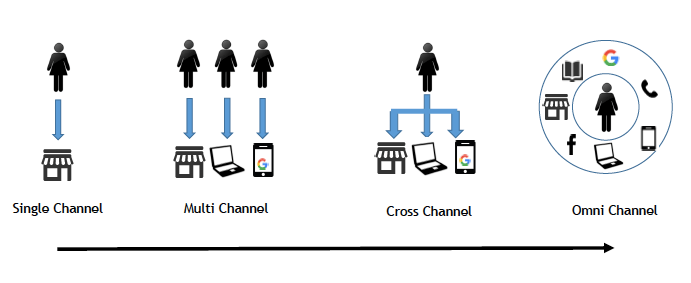
And now it has moved to the omnichannel marketing where you’ve realized that even cross-channel marketing is a myopic view, and you’re looking at a customer as the end, not the channels as the entity where the conversion needs to be maximized. It’s not that I need to maximize the conversions from SEM or Facebook as a channel, but rather I have so many customers and I need to maximize the conversions coming out of so many customers.
Now, what has led to this shift from the simpler version of marketing to the more complex version of omnichannel marketing? Some very large ecosystems have evolved in the recent times leading to this large shift in the marketing has happened.
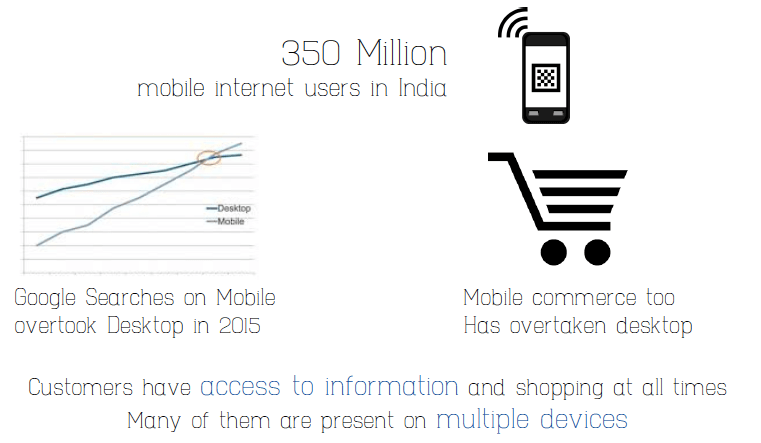
The first large factor is mobility. Mobile internet has already surpassed desktop internet in a big way. Coupled with the growth of the use of smartphones, this has led to some very large changes in how people use the internet. Mid of 2015, the volume of Google searches on mobile overtook the volume of Google searches on desktop. Around the same time, most e-commerce players started seeing their mobile e-commerce overtake their desktop e-commerce.
E-commerce apps on mobile became a whole new and very important storefront for all of the online retailers. This mobility brought about two large changes in the behavior of the customer. First, the customers live access to information and shopping at all times. They can be negotiating with an offline store staff. At the same time they might be maybe checking out the prices on the internet and using that to do the negotiation. Secondly, the number of devices the customer was using to access your stores double. They might be conducting a part of their purchase flow on one device and a part on the other. So this has disrupted the previously imagined linear flow of purchase.
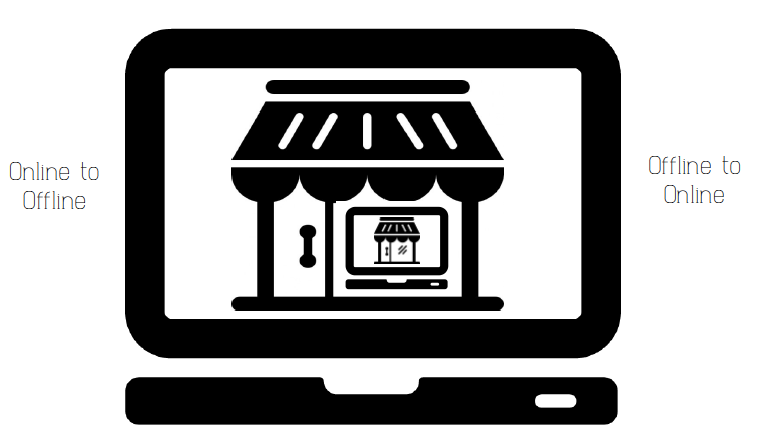
The second large factor at play is the hybrid model. Offline merchants started venturing online, online merchants started having offline stores. And for a very, very good reason because the omnichannel marketing solves the problem that each of these two channels had individually. Offline merchants are interested in having an online presence for a variety of reasons, key of them would be one, e-commerce is a fast-growing pie. While the growth in the offline channels, offline retail channels is usually a single digit or low double digit number, the e-commerce pie has grown multifold year on year in the recent years.
Secondly, real estate is expensive in offline stores. A typical brand can afford to keep just a few hundred products in their offline stores.
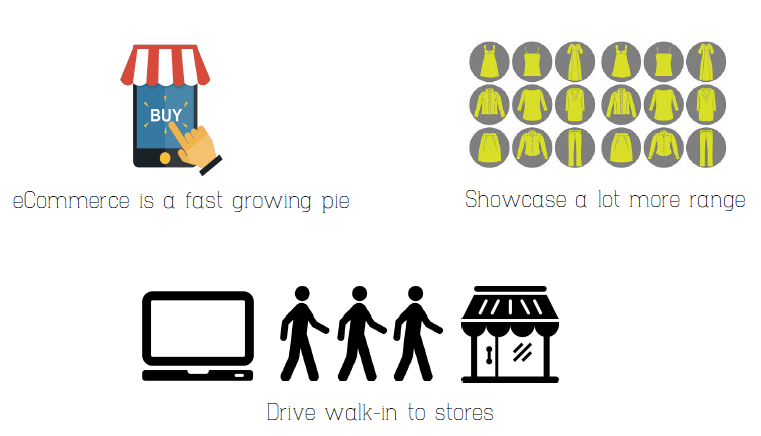
A destination, if they have it, it allows them to put a much larger range of products in front of the customer and requires a much cheaper cost of restoring the inventories and then the warehouse. Thirdly, even brands that do not intend to sell online have recognized the importance of digital as a media. They want to use internet as a marketing medium to drive footfall to their offline stores, and as an engagement medium to interact with their customers.
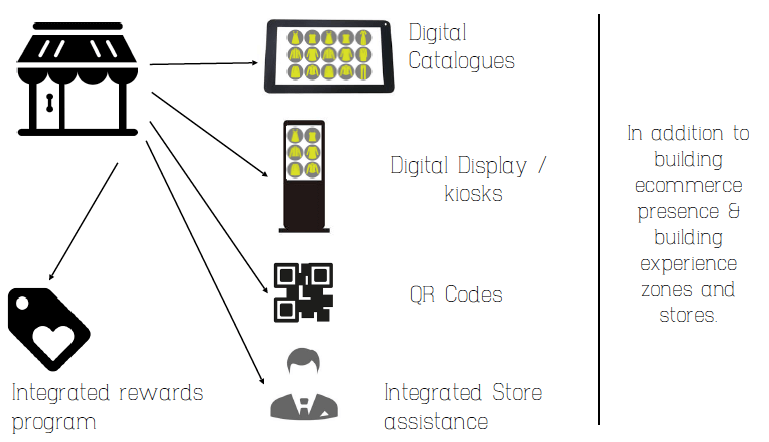
Apart from having presence across online stores or mobile web stores or a mobile app or being there on a marketplace, there are a few other things that brands are doing to increase their omnichannel reach. The brands are building digital interactions in their stores by equipping these stores with digital catalog, digital kiosks where the customer is able to browse through a lot more inventory than they would have been able to otherwise do in the offline store, by facilitating the customer engagements through having activities which are based on fewer goods.
It also gives back to the brand some information around the customer that they can use to improve their experience, and they’re empowering their sales staff with the customer’s history so the sales staff is able to give a lot better and seamless experience to the customer. Brands are building loyalty programs that span across online and offline so the customer is able to move between the two without a feeling of deception.
Online stores, on the other hand, are building their offline presence for a variety of important reason as well. We’ve seen players like Pepper Fry, FirstCry, Lenskart build important offline presence through their retail stores or experiences stores. The first key reason is that offline market is still huge. In many categories where e-commerce is present, the offline market is still upwards of 90-95%, especially for niche brands which operate within a certain category within the e-commerce space, they’ll get even more constraint by the small internet penetration of the company. And hence, it’s part their growth plans. It becomes much more important to have an offline feature as well.
Secondly, some online stores are able to give a much better brand experience by making the customer’s experience a lot more holistic. You can imagine the difference between an Apple store in the offline space and an Apple store in the online space. Thirdly, there are categories where customers might prefer a touch and feel before they buy. This is especially true for high involvement categories and non-commodity, high ticket items. The hybrid model is presenting marketers with a lot of opportunities and challenges. It is important to solve these challenges because all of the constraints that each of them have individually been facing get resolved by having an omnichannel presence across online and offline retail segments, both.
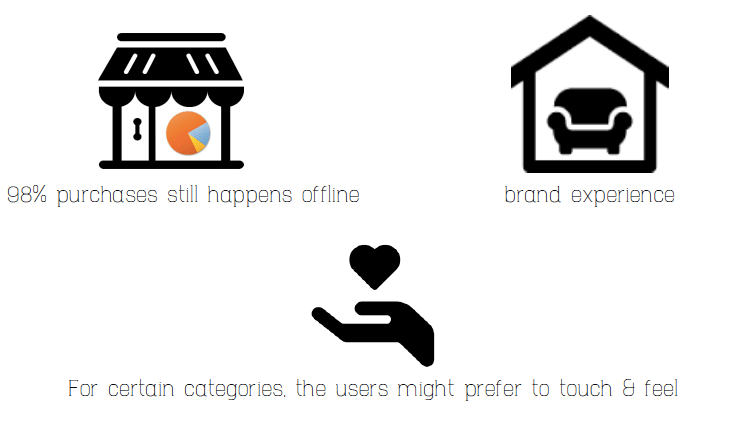
The third large reason behind the shift to omnichannel is data. Two billion bytes of data is being created every day. For any of us who have an online or an offline store, there’s an opportunity to track and use information about the customer’s profile, their contact information, geographic information, visit history, order history, the feedback that’s coming from them and lots more. And with this great data that we’re able to receive also comes the big responsibility of using it to improve the customer’s experience.
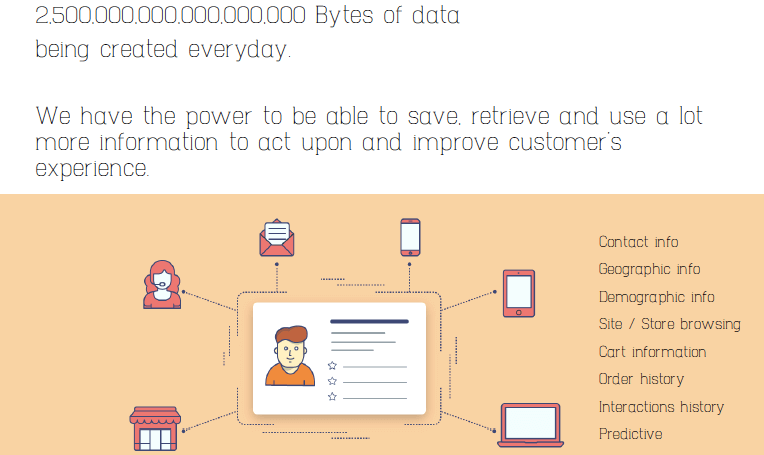
The fourth and the last large factor behind the shift in marketing to an omnichannel way is the availability of loads of content and information across the internet. Our customers are able to now access all of this information at their fingertips. They’re no more relying on the information that the brand is providing. The customers get information about the product, about the price, about the availability, reviews in an instant. And it’s a two-way channel where they’re also talking about you and making their opinions available for other customers.
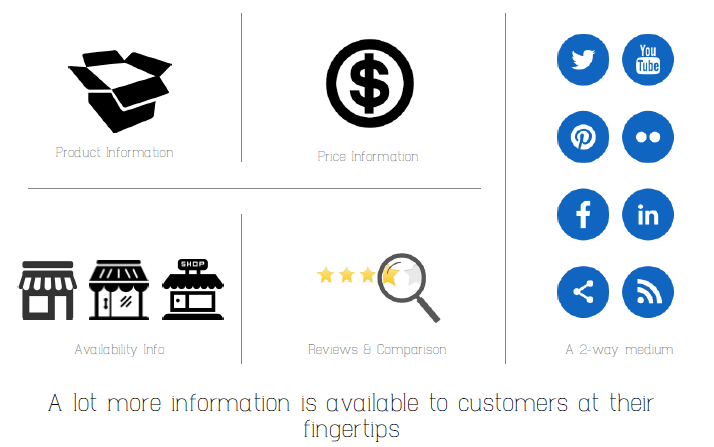
So with mobility, hybrid models, availability of data for marketers, and availability of information for customers, it has become even more important to shift gears away from the old school of marketing and put the customer at the center of the omnichannel marketing, maximizing the conversion per customer rather than the conversion per marketing channel or conversion per retail channel. Instead of saying, “I have to maximize conversion from X million impressions in my Facebook Ads,” we have to be able to say, “We have X million potential customers, and I need to maximize the number of conversions that I’m able to obtain from this pool.”
Let’s look at some basic steps needed to implement a good omnichannel marketing. First and most important will be understanding your customers. While this is very basic over a course of trying to deal with daily ROI, marketers drift away from the knowledge of their customers. We have to be clear about who our customer is. Can they be segmented? This is their behavior pattern. How are they discovering us? What does their purchasing decision making look like? To what extent is it based on pricing or service or product research? What is the feedback that we’re getting from them, and how can that feedback be used to improve everyone’s experience?
It will include tracking and building customer profile through all sources of data possible. It will include understanding what platforms and marketing channels they’re interacting with. It will include a proactive feedback tracking and understanding what is it that their opinion on us is about. And it will include blending all of this data into one single view. Now, when you try to integrate this data, channel devices and touch point into a single omnichannel strategy, you’ll have to break a lot of silos within your organization.
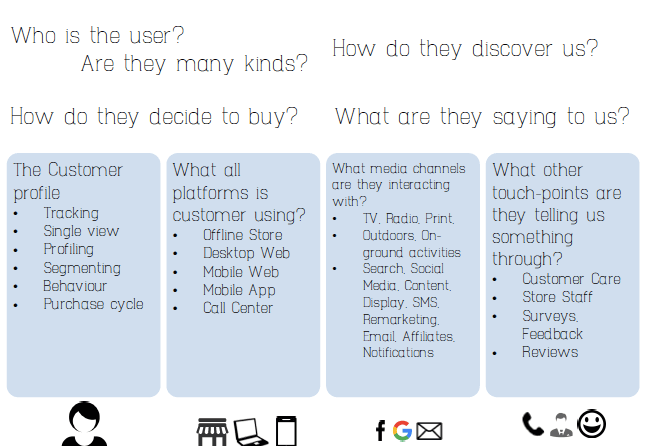
As organizations grow, the business goals get broken into department KRAs, and that leads to compartmentalization. The marketing team will look at only at their channel ROIs, the retail team will look at business coming from their individual retail channel, the customer care team will worry about the number of calls handled per day. What’s needed is to break all of these silos, understand that all of these are elements that come at some point of time along the customer’s journey to purchase, and all of these steps have to be integrated to optimize the customer sale.

We have to also understand that these channels and functions play a different role in customer’s journey. A CRM channel will be fulfilling a very different purpose than let’s say a brand marketing channel. A customer care function will be fulfilling a completely different purpose. We have to recognize the place and the influence of these elements in the customer’s journey, and also their influence on each other. The influence of one marketing channel upon the rest is very much measurable. As much as possible, brands adopt one of the following approaches.
One, by going media dark adopting one channel, you can look at the delta impact that it creates across other channels and in total. Some tools like Google Analytics also give you a report called the multi-channel assistant score, which is basically a ratio of the number of conversions that have been assisted by a particular channel to the number of conversions that have been attributed to this particular channel. Now, the higher this score, which we can imagine will be in the case of, let’s say, the display campaigns which come at the start of the customer’s flow, the more helpful that channel is to all of these channels.
And similarly, we’ll have to make our investments and ROI benchmarks based on this score. Lastly, some brands have also developed the in-house tools to be able to track and report this overlap data and report the overlap between different marketing channels, the overlap between different devices. And they’re trying to tie it to the customer’s identity as much as possible. Wherever the customer is logging in, wherever the customer is giving you identity information, hat gets married to all of these data collected to be able to give you one single view of the customer.
We also have solutions like WebEngage Journey, which accomplishes the same purpose. In fact, that’s a solution which has been made public today via Firstcry in the stages of pilot integration. And it’s a method to be able to comprehensively see the customer’s journeys across all different platforms and devices and marketing channels, including the offline. And the bring them all together, and then segment it, carry out your marketing activities, carry out your CRM notification, SMS activities, depending on what each…what is best for each segment of the customer.
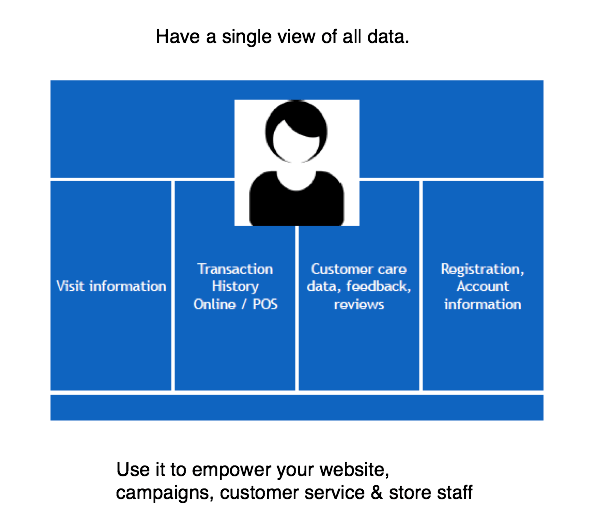
The third and the fourth important parts to omnichannel marketing are related to data and analytics. As a first step, we have to make a comprehensive single view of the customer that we’re talking about. Bring all account information, registration information, visit information, order history, feedback history into one single view. And then this view has to be provided to empower your website, your campaigns, your customer service, your store staff, and all other touch points. They have to receive this data and make the best use of it in the manners possible in their domains.
Once you do this, you’re…for example, your CRM system will know which customers need a little extra push to come back again. They might be slightly slow their past experience from their order and this is data that will come to you. From the customer care end, you will know that these people need a little extra incentive to be brought back. On your brand, display campaigns will know how to eliminate customers who are very loyal users, who are anyway engaging with your store a lot. And hence, a new fresh brand campaign aimed at reaching out to fresh audience and explaining them your proposition might not be needed to be delivered to them at all.
As a second step to data, integrate the working of marketing and analytics function. The marketing function doesn’t stop at CPCs and CPAs of marketing channels alone. The marketing functions has responsibilities to maximize the conversion per customer. And for this, we’ll have to equip them with all the data that we mentioned earlier. They have to understand the interplay of channels on one other and prepare their marketing mix accordingly.
They have to also understand the long-term value of the customers from the campaign that they have been acquired. Sometimes it is surprisingly discovered that the campaign that was looking like…looking poorer on ROI starts working better once you look at their long-term ROI. Similarly, some over incentivized campaign tend to show attractive immediate results, but might not be bringing customers that will stick to you to give you a long-term return.
The marketing team has also to…also needs to analyze the nature of the audience and work accordingly. For example, a customer…a campaign which is aimed at new customer acquisition can eliminate your loyal customers. Similarly, a campaign which is aimed at a loyalty rewards program might not need to be shown to a fresh user there.
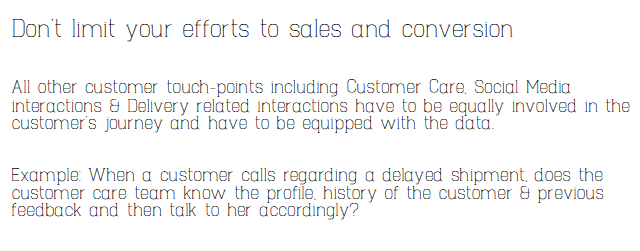
The fifth part to building an omnichannel strategy would be to not limit it to sales and marketing alone.
Not all the effects of omnichannel strategy will be measurable in terms of money. I might be a very loyal customer but if I call your call center and I don’t receive that recognition that you know who I am and if I have to repeat my entire story having explained it already, someday I’ll not be calling it a good experience. The sixth part to omnichannel marketing strategy would be to reach to customers based as their preferred mode of communication.
If I’m a customer who has your mobile app and I interact with the push notifications, really it will be really unintelligent to send me an SMS that asks me to log on to www.yoursite.com. And be receptive to any modes that the customer tries to reach to you. Sometimes the customer will post their order ID on your social media page asking for delivery results and delivery status. Equip the social media team to be able to handle such queries intelligently, rather than asking them to call on your toll-free number between 9 am and 6 pm.
So this last part to building an omnichannel marketing is about building seamlessness. The customer’s experience should travel between devices and platforms as smoothly as possible. Brands are achieving it through engaging users to remain logged in, thus being able to carry their product recommendations and order history from one device to the other. Brands are building teams that can intelligently reply to a customer’s query posted across all touch points, whether it be internal or external.
Now, some of these building blocks of omnichannel marketing that we have spoken about also come with certain challenges that we’ll encounter and we’ll have to overcome. Firstly, we’re talking about gathering a huge volume of data, of making it available to many relevant teams in a useable manner. We’re talking about building analytical capabilities within the marketing team. These capabilities will have to be on priority to be developed at the organizational level, at the technology level, and the marketing and analytics levels.
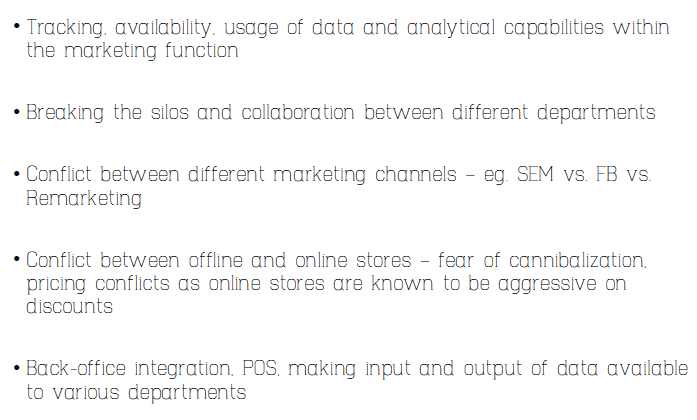
The second, which is the task of breaking the departmental silos, is also really important to be accomplished at an organizational level. As organizations grow, the departments tend to get compartmentalized. The sharing of learning and communication breaks down and that’s one big challenge that needs to be accomplished at an organizational level to be able to give a really seamless experience to the customer by having your functions integrated seamlessly.
Thirdly, the marketing function will have to work on the conflicts within marketing channel. There are a lot of attribution level conflicts which need to be recognized and the investment and performance benchmarks will have to be set for each of these channels accordingly. For example, a myopic plan would have a lot of investment made towards the end of the final channels because the ROI there looks good if such conflicts have not been resolved.
Fourthly, as it has already been witnessed all around us, the online and offline channels undergo a lot of conflict. The…especially on pricing, the offline channels work with a lot stricter unit requirements than the online channels have traditionally enjoyed. The offline channels fear cannibalization and damage to their economics whenever a coherent strategy is attempted to be used. Brands are trying to unify their pricing decisions across their online and offline store to be able to resolve this issue.
The fifth and the last challenge that we talk about would be about implementing systems within the offline space, especially because the offline retailers have traditionally been very slow on data gathering and implementing appropriate point of sales infrastructure. There are certain things that can be bought off the shelf in the market that or can also develop it in-house. By having certain infrastructure at the point of sales, you’re able to collect a lot more information about the customer. You also can give a lot more reason to the customer for them to share the data that you’re asking of them. And that’s one large step that needs to be taken and that one last challenge that needs to be overcome in this direction.
So in summary, we understand that the customers have evolved and marketing has evolved with them from a myopic funnel kind of view to a holistic view which got just everything that influences a customer’s journey. This changes the impact and the influence that marketers have in the organization and towards the business world where marketers are trying to maximize the customer’s ease and experience when they go through their purchase channel.
This view spans across channels, across devices, across functions within the organizations, across online and offline, and it always has the customer at the center. Thank you. We’ll be opened for questions.
Questions & Answers
Avantika: Thank you, Vivek. It was such an insightful webinar. We’ll now take the questions.
Okay, so we have our first question.
It’s from Alex. He’s asking, “Are there any in which retailers approach the sharing of inventory and fulfillment to satisfy the customer base?”
Vivek: Okay, okay. Got it Avantika. So let’s look at first the constraints faced by retailers in the offline space. And there’s a large… so let’s look at the constraint being faced in the online space and the offline space together. In the offline space, at max a few hundred SKUs is what a retailer will be able to keep at any point of time in the retail store. And what that means is that even if they have a lot more variety and size and color to be able to sell, the customer never is able to see or obtain them.
This gets resolved through some of the methods that we mentioned earlier, which is a digital catalogue within the store, either in form of a tablet or in form of a kiosk or even as a point of sales software that you have which allows customer to be able to buy a lot more than what you have in the store. It really helps. To give you an example, if I have 100 different design of apparel across 10 different colors, across 10 different sizes, that becomes 10,000 different things to keep in my store.
On the other hand, if I keep one of each design, one of each color, and one of each size, I’ll be able to do the job in a lot less and for a customer who likes a particular design and color, but does not find the right size in the store at that point of time, will be able to order it through the catalogue and get it from the warehouse through that digital medium. So that becomes one way in which inventory gets used really properly through an online-offline marriage of…which we’re calling it as the omnichannel retail strategy.
Similarly, on the online side, online retailers have a large warehouse and they have a web storefront. So they’re able to see…show maybe lots of different SKUs to the customer. The issue that they’re facing is that the touch and feel element is missing. They can similarly accomplish it by having even a retail store or even just an experience store where the customers are able to come and see a sample of what they’re going to buy and satisfy their queries.
So by marrying these two, what we’re able to do is to have a very, very large amount of inventory sitting somewhere in the warehouse and bringing it in front of the customer in a manner which is feasible, realistic wise, and we’re able to accomplish that purpose. Now, the systems which will be required to be able to develop this, there are several off the shelf systems available. I know of Browntape, there’s an ex-colleague who now works there, which is both a platform as well as a managed service which will be able to accomplish this for anybody who has a large inventory and wants to have the best way to be able to showcase online.
Avantika: All right. The next one is from Rabuka. She’s asking, “How can your company connect internal silos to ensure access to all the critical data you need?”
Vivek: Okay. So of course, the first fight is about having a change at the thought level within the organization where we’ll have to understand that we’re not working for our own KRAs or our own departmental KRAs, but rather as for the organizations who are our objective. And that will come when the departments start talking to each other, start sharing their learnings. And this can be instituted very formerly by having interdepartmental sessions where people learn about the workings and the impact of the other department.
The second would be once it really comes to being able to share data within different departments, like we were talking about, making data available across all of these departments from the analytics even when very natural issues around the privacy of the data, around the confidentiality of the data, these can be addressed. For example, the way we do in my organization we have encrypted all the contact details, email ID, phone numbers of the customers. And what is available at the front end for anybody to see is only the encrypted entity and not the real contact details behind it. And thus we’re able to be a lot more open to sharing our data within the different departments.
And of course, at a basic level before being able to share all of this data, you need to be able to also get all of these functions to input the data that they’re gathering at their end. So there needs to be a single place where all of this data gets stored, get weaved together to be able to be presented as and when required. Have a customer satisfaction metric that is an organization level target and metrics that has been observed and chased. A very good representation of it can be the NPS, which is the net promoter score.
It’s a very standard score that is recognized as the indicator of how good your business is for the customers. It’s basically one single question which asks customers how likely they are to recommend you to their friends and colleagues. And then a formula gets applied on the results and you get an NPS score. It’s a standard score that is measured across several organizations, and is a very good indicator of whether a customer is satisfied with the experience that you’re giving them.
Have this score as a target and objective that all people and all functions within the organization are chasing. So, if you’re able to work on the hard data and its availability, and secondly on the thought level changes required, you should be able to manage a good connection between the silos that exist otherwise.
Avantika: All right. The next one is from Paolo and he wants to know, “How will you track where and how your customers interact with your brand?”
Vivek: Okay. Can you repeat that question, Avantika, sorry?
Avantika: It’s how will you track where and how customers interact with your brand?
Vivek: Okay, okay. So I think it’s fairly large and wide but it’s also natural to do and easy to be the score. One, of course you have a large volume of incoming requests that come to you in an organized place, such as the customer service department. They will have methods to record all of this interaction and record the responses that they’re giving to them by the customer, by the order number, by their phone number, email IDs, etc.
Also be very open and equip all your social media teams to be able to record and respond to conversations across all social media properties. So the obvious one would be, let’s say Facebook and Twitter. And there’ll also be questions that will be coming…that will be posted by customers on your product pages. There’ll be people who might be writing to your email IDs directly.
There’s also a very large volume of proactive feedback seeking that can be done by using surveys. We use WebEngage surveys a lot. Like, almost all is at least one survey running somewhere on the website asking customers to proactively give us some idea about the product, of the quality range, of the transaction experience, of the delivery experience. There’s always one or the other questions which is running.
So by having a good tracking mechanism within your customer care, you’ll be able to do 80% of the information collection, and it will be very, very rich because thousands of people might be calling there and then it will be a large volume of data, very useful about what is the problem they’re facing. And also work on the remaining 20% which is, one, making sure that your data gathering and responding is happening on social media channels, and secondly, be proactive about going ahead and asking questions around anything that they want to know about.
Avantika: All right. Next one is from Pankaj. He says, “You would have used or come across many CRM tools for omnichannel marketing. Which ones would you suggest for us, picking suggestions as we’re about to launch mobile app and website for our online business?”
Vivek: All right. So, Pankaj, yes, we have used several CRM tools. At one point of time, it used to be only about emailing, and then it moved to being about SMS and then about app notifications. I’ll tell you the tools that we’re using today and we’ve used in the past. So we’ve found for emailing reasons continues to be a very powerful tool. We have used for quite some bit of time, and we also have later developed the more comprehensive tools within…or more comprehensively particularly for the kind of use case that we had, we’ve developed it in-house as well.
On the website, we’re using WebEngage right now. On the mobile app, we’re using MoreEngage. We’re also piloting with WebEngage Journey, which looks to me, at this moment, a very, very comprehensive tool to go forward with. By having WebEngage Journey capture data across your desktop web, mobile web, mobile app CRM channels, you’re able to get a lot of data coming together. And this tool also tries to marry it to the customer’s identity.
So after a little bit of data collection, you will have a customer’s identity linked to the kind of behavior that. And if you integrate all of these tools with your email sending, SMS sending, and notifications platforms, then you’ll be able to, from within these tools, segment. Let’s say I want to send a push notification to everybody who has an app, but the target might have ended yesterday, I’ll be able to do that within one single view.
Build a journey. Build my multi step journey, which also says actually they don’t respond to this push notification. Then send in an SMS, if they don’t respond to SMS, then send them an email, if they don’t respond to email, then XYZ. A mighty step, very comprehensive journey of all customers can be built through the WebEngage Journey. And as I understand today, we have about to start that pilot. So we got some later. And I also understand that it has been launched to the public today, so there might be some other literature that will be available on the blog section.
So those are the CRM tools that we need. We have found tools to be slightly short here and there, and which is why some of our CRM also happens in-house. But I’m hoping that we’ll be able to…a lot of people are working on making it comprehensive, and I’m sure we’ll have a good tool sometime very soon.
Avantika: All right, Vivek. I think due to running out, since we’re running out of time, we will be not be taking any more questions, and but we’ll make sure that we email you the answers just after right after this webinar. Thank you so much, Vivek, for answering our queries. And thank you, everyone, for being such a wonderful audience. That’s it for now. Guys, don’t forget to tune in to www.monk.webengage.com to make sure that you never miss out on any offer right from us. Thank you so much and have a great day. Bye-bye.
Vivek: Thanks, everyone. Thanks, Avantika.




